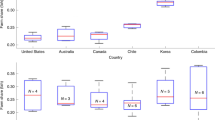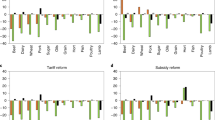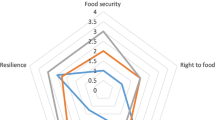Abstract
Sustainable food consumption studies have largely focused on promoting human health within ecological limits. Less attention has been paid to social sustainability, in part because of limited data and models. Globally, agriculture has one of the highest incidences of forced labour, with exploitative conditions enabled by low margins, domestic labour scarcity, inadequate legal protections for workers and high labour requirements. Here we assess the forced labour risk embedded in the US retail supply of fruits and vegetables using distinct datasets and a new forced labour risk scoring method. We demonstrate that there is risk of forced labour in a broad set of fruit and vegetable commodities, with a small number of commodities accounting for a substantial fraction of total risk at the retail supply level. These findings signal potential trade-offs and synergies across dimensions of food system sustainability and the need for novel research approaches to develop evidence-based forced labour risk mitigation strategies.
This is a preview of subscription content, access via your institution
Access options
Access Nature and 54 other Nature Portfolio journals
Get Nature+, our best-value online-access subscription
$29.99 / 30 days
cancel any time
Subscribe to this journal
Receive 12 digital issues and online access to articles
$119.00 per year
only $9.92 per issue
Buy this article
- Purchase on Springer Link
- Instant access to full article PDF
Prices may be subject to local taxes which are calculated during checkout



Similar content being viewed by others
Data availability
All results data generated during the study and select input data are available in the Supplementary Information. The supply and origin data that support the findings of this study are available from the FAO (http://www.fao.org/faostat/en/#data) and the US Department of Agriculture, Economic Research Service (https://www.ers.usda.gov/data-products/food-availability-per-capita-data-system/). The price data that support the findings of this study are available from the US Department of Agriculture, Economic Research Service (https://www.ers.usda.gov/data-products/fruit-and-vegetable-prices/). The forced labour and governance data that support the findings of this study are available from the US Department of Labor, Bureau of International Labor Affairs (https://www.dol.gov/agencies/ilab), US Department of State, Bureau of Democracy, Human Rights, and Labor and Office to Monitor and Combat Trafficking in Persons (https://www.state.gov/), Verité (https://www.verite.org/) and the Walk Free Foundation (https://www.globalslaveryindex.org/about/the-index/). All other data are available from the corresponding author upon reasonable request. Source data are provided with this paper.
Code availability
R code supporting this study is available from the corresponding author upon reasonable request.
References
Global Estimates of Modern Slavery: Forced Labour and Forced Marriage (International Labor Organization & Walk Free Foundation, 2018).
Sustainable Development Goals Knowledge Platform (United Nations, 2020).
The Meanings of Forced Labour (International Labor Organization, 2014); https://www.ilo.org/global/topics/forced-labour/news/WCMS_237569/lang--en/index.htm
Allain, J., Crane, A., LeBaron, G. & Behbahani, L. Forced Labour’s Business Models and Supply Chains (JRF, 2013); https://www.jrf.org.uk/sites/default/files/jrf/migrated/files/forced-labour-business-full.pdf
LeBaron, G., Howard, N., Thibos, C. & Kyritsis, P. Confronting Root Causes: Forced Labour in Global Supply Chains (openDEMOCRACY & SPERI, 2018); https://eprints.whiterose.ac.uk/126167/1/Confronting_Root_Causes_Forced_Labour_In_Global_Supply_Chains.pdf
Strengthening Protections Against Trafficking in Persons in Federal and Corporate Supply Chains: Research on Risk in 43 Commodities Worldwide (Verité, 2017).
A Summary of Challenges on Addressing Human Trafficking for Labour Exploitation in the Agricultural Sector in the OSCE Region (Organization for Security and Co-operation in Europe, 2009); https://www.osce.org/files/f/documents/b/4/37937.pdf
New, S. J. Modern slavery and the supply chain: the limits of corporate social responsibility? Supply Chain Manage. 20, 697–707 (2015).
Gold, S., Trautrims, A. & Trodd, Z. Modern slavery challenges to supply chain management. Supply Chain Manage. 20, 485–494 (2015).
Kühnen, M. & Hahn, R. Indicators in social life cycle assessment: a review of frameworks, theories, and empirical experience. J. Ind. Ecol. 21, 1547–1565 (2017).
Grubert, E. Rigor in social life cycle assessment: improving the scientific grounding of SLCA. Int. J. Life Cycle Assess. 23, 481–491 (2018).
Benoît-Norris, C., Cavan, D. A. & Norris, G. Identifying social impacts in product supply chains: overview and application of the Social Hotspot Database. Sustainability 4, 1946–1965 (2012).
Zira, S., Röös, E., Ivarsson, E., Hoffmann, R. & Rydhmer, L. Social life cycle assessment of Swedish organic and conventional pork production. Int. J. Life Cycle Assess. 25, 1957–1975 (2020).
Pelletier, N. Social sustainability assessment of Canadian egg production facilities: methods, analysis, and recommendations. Sustainability 10, 1601 (2018).
Du, C., Ugaya, C., Freire, F., Dias, L. C. & Clift, R. Enriching the results of screening social life cycle assessment using content analysis: a case study of sugarcane in Brazil. Int. J. Life Cycle Assess. 24, 781–793 (2019).
Benoît-Norris, C., Bennema, M. & Norris, G. A. The Social Hotspots Database Version 4 (NewEarth B, 2019).
Mears, B. 6 charged in human trafficking scheme involving Thai workers. CNN (3 September 2010).
Shah, R. Rainforest Alliance certifying unethical pineapple farms, activists claim. The Guardian (29 May 2020).
Larsson, N. Human rights in Thailand: Andy Hall’s legal battle to defend migrant workers. The Guardian (22 January 2016).
Linthicum, K. Inside the bloody cartel war for Mexico’s multibillion-dollar avocado industry. Los Angeles Times (21 November 2019).
Dehghan, S. K. Are Mexican avocados the world’s new conflict commodity? The Guardian (30 December 2019).
Godoy, E. Migrant farm workers, the main victims of slave labour in Mexico. Inter Press Service (9 April 2019).
Marosi, R. Product of Mexico: hardship on Mexico’s farms, a bounty for U.S. tables. Los Angeles Times (7 December 2014).
2018 List of Goods Produced by Child Labor or Forced Labor (Bureau of International Labor Affairs, US Department of Labor, 2018); https://www.dol.gov/sites/dolgov/files/ILAB/ListofGoods.pdf
2020 Food & Beverage Benchmark Findings Report (Know the Chain, 2020); https://knowthechain.org/wp-content/uploads/2020-KTC-FB-Benchmark-Report.pdf
Fair Food Program (Fair Food Program, 2020); https://www.fairfoodprogram.org/
Lindgren, K. Justice in the Fields: A Report on the Role of Farmworker Justice Certification and an Evaluation of the Effectiveness of Seven Labels (Fair World Project, 2016); https://fairworldproject.org/wp-content/uploads/2016/10/Justice-In-The-Fields-Report.pdf
LeBaron, G., Lister, J. & Dauvergne, P. Governing global supply chain sustainability through the ethical audit regime. Globalizations 14, 958–975 (2017).
Heller, M. C. & Keoleian, G. A. Greenhouse gas emission estimates of U.S. dietary choices and food loss. J. Ind. Ecol. 19, 391–401 (2015).
Conrad, Z. et al. Relationship between food waste, diet quality, and environmental sustainability. PLoS ONE https://doi.org/10.1371/journal.pone.0195405 (2018).
Birney, C. I., Franklin, K. F., Davidson, F. T. & Webber, M. E. An assessment of individual foodprints attributed to diets and food waste in the United States. Environ. Res. Lett. 12, 105008 (2017).
Conrad, Z. Daily cost of consumer food wasted, inedible, and consumed in the United States, 2001–2016. Nutr. J. 19, 35 (2020).
Spiker, M. L., Hiza, H. A. B., Siddiqi, S. M. & Neff, R. A. Wasted food, wasted nutrients: nutrient loss from wasted food in the United States and comparison to gaps in dietary intake. J. Acad. Nutr. Diet. 117, 1031–1040 (2017).
OECD-FAO Guidance for Responsible Agricultural Supply Chains (OECD & FAO, 2016).
Food and Agriculture Benchmark (World Benchmarking Alliance, 2020); https://www.worldbenchmarkingalliance.org/food-and-agriculture-benchmark/
FAOSTAT: Value of Agricultural Production (FAO, 2021); http://www.fao.org/faostat/en/#data/QV
Friscolanti, M. Canada’s uncomfortable reliance on migrant workers. Macleans.ca (28 April 2016).
Crane, A., LeBaron, G., Allain, J. & Behbahani, L. Governance gaps in eradicating forced labor: from global to domestic supply chains. Regul. Gov. 13, 86–106 (2019).
Berliner, D., Greenleaf, A. R., Lake, M., Levi, M. & Noveck, J. Governing global supply chains: what we know (and don’t) about improving labor rights and working conditions. Annu. Rev. Law Soc. Sci. 11, 193–209 (2015).
Hodkinson, S. N., Lewis, H., Waite, L. & Dwyer, P. Fighting or fuelling forced labour? The Modern Slavery Act 2015, irregular migrants and the vulnerabilising role of the UK’s hostile environment. Crit. Soc. Policy https://doi.org/10.1177/0261018320904311 (2020).
Milk with Dignity First Biennial Report: 2018-2019 (Migrant Justice & Milk with Dignity Standards Council, 2020); https://milkwithdignity.org/sites/default/files/2020MDReport.pdf
Costa, P. T. M. Fighting Forced Labour: The Example of Brazil (International Labour Office, 2009).
Clarembaux, P. & Toral, A. Potato slaves. Univision (6 August 2020).
The hands that feed us. Nat. Food 1, 93 (2020).
Food Balances (Old Methodology and Population) (FAO, 2020).
Kim, B. F. et al. Country-specific dietary shifts to mitigate climate and water crises. Glob. Environ. Change 62, 101926 (2019).
Food Balance Sheets: A Handbook (FAO, 2001).
Detailed Trade Matrix (FAO, 2020).
Food Availability (Per Capita) Data System (Economic Research Service, US Department of Agriculture, 2019); https://www.ers.usda.gov/data-products/food-availability-per-capita-data-system
Benoît Norris, C., Bennema, M. & Norris, G. The Social Hotspots Database: Supporting Documentation, Update 2019 (NewEarth B, 2018).
Fruit and Vegetable Prices (Economic Research Service, US Department of Agriculture, 2018); https://www.ers.usda.gov/data-products/fruit-and-vegetable-prices/
Annual Industry Accounts (Bureau of Economic Analysis, US Department of Commerce, 2012); https://www.bea.gov/industry/industry-underlying-estimates
2018 Country Reports on Human Rights Practices (US Department of State, 2018); https://www.state.gov/reports/2018-country-reports-on-human-rights-practices/
Trafficking in Persons Report (Office to Monitor and Combat Trafficking in Persons, US Department of State, 2019); https://www.state.gov/wp-content/uploads/2019/06/2019-Trafficking-in-Persons-Report.pdf
The Global Slavery Index 2016 (Walk Free Foundation, 2016); https://www.globalslaveryindex.org/resources/downloads/
Calvin, L. & Martin, P. Labor-Intensive U.S. Fruit and Vegetable Industry Competes in a Global Market (ERS, 2010); https://www.ers.usda.gov/amber-waves/2010/december/labor-intensive-us-fruit-and-vegetable-industry-competes-in-a-global-market/
Fruits and Nuts (Verité, 2018).
Martin, P. & Taylor, J. E. Ripe with Change: Evolving Farm Labor Markets in the United States, Mexico, and Central America (Migration Policy Institute, 2013); https://www.migrationpolicy.org/research/ripe-change-evolving-farm-labor-markets-united-states-mexico-and-central-america
Rees, M. in Choice in Economic Contexts (Research in Economic Anthropology Vol. 25) (ed. Wood, D. C.) 27–50 (Emerald Group, 2006).
ILO Indicators of Forced Labour (ILO, 2012); https://www.ilo.org/global/topics/forced-labour/publications/WCMS_203832/lang--en/index.htm
Acknowledgements
We gratefully acknowledge E. Rodríguez-Huerta, who assisted with the preparation of the final figures. J.L.D.S. was supported by the Nottingham Research Fellowship, University of Nottingham. T.R. was supported by the Friedman School of Nutrition Science and Policy, Tufts University. The funders had no role in study design, data collection and analysis, decision to publish or preparation of the manuscript.
Author information
Authors and Affiliations
Contributions
N.T.B. and J.L.D.S. conceptualized the study. N.T.B., C.B.N. and J.L.D.S. designed the methodology. N.T.B. developed the code. T.R., B.J., J.L.D.S., C.B.N. and N.T.B. collected and analysed the data. N.T.B. and J.L.D.S. wrote the original draft, and all authors contributed to editing and revising the manuscript. N.T.B. and J.L.D.S. supervised and administered the project. All authors reviewed and approved the final manuscript.
Corresponding author
Ethics declarations
Competing interests
N.T.B., J.L.D.S., T.R. and B.J. declare no competing interests. C.B.N. declares that she began a position as a Research Scientist in Social Responsibility with Amazon when this research was near completion. Her contribution to this research has been as an independent expert consultant in social life cycle assessment and separate from her role at Amazon. C.B.N. is also the Chief Operating Officer of NewEarth B and Executive Director of the Social Hotspots Database project. Data from the Social Hotspots Database were provided free of charge for academic use in this research.
Additional information
Peer review information Nature Food thanks Stefan Gold, Erin O’Connor and the other, anonymous, reviewer(s) for their contribution to the peer review of this work.
Publisher’s note Springer Nature remains neutral with regard to jurisdictional claims in published maps and institutional affiliations.
Supplementary information
Supplementary Information
Supplementary Fig. 1 and Methods.
Supplementary Data 1
Supplementary Tables 1–8.
Source data
Source Data Fig. 1
Source data for per-serving risk of fruit.
Source Data Fig. 2
Source data for per-serving risk of vegetables.
Source Data Fig. 3
Source data for proportions in contribution analysis.
Rights and permissions
About this article
Cite this article
Blackstone, N.T., Norris, C.B., Robbins, T. et al. Risk of forced labour embedded in the US fruit and vegetable supply. Nat Food 2, 692–699 (2021). https://doi.org/10.1038/s43016-021-00339-0
Received:
Accepted:
Published:
Issue Date:
DOI: https://doi.org/10.1038/s43016-021-00339-0
This article is cited by
-
Inequality in economic shock exposures across the global firm-level supply network
Nature Communications (2024)
-
Low-carbon diets can reduce global ecological and health costs
Nature Food (2023)
-
Forced labour risk is pervasive in the US land-based food supply
Nature Food (2023)
-
Forced labour in US food supply chains
Nature Food (2023)
-
Global food systems transitions have enabled affordable diets but had less favourable outcomes for nutrition, environmental health, inclusion and equity
Nature Food (2022)



